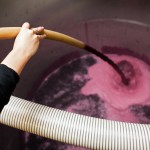Adding pectic enzyme to your wine
Pectic enzyme at a glance
- AKA pectinase
- A protein that breaks down pectin within fruit
- Added to juice or must pre-fermentation
- No notable downside of using this additive
- Available in powder or liquid form
Right… but why is it important?
- Using pectic enzyme increases juice, tannin, flavor, and color extraction
- Aids in clearing wine by eliminating potential “pectic haze”
Who should use pectic enzyme?
If you’re making wine of any kind, whether from grapes or any other fruit, adding pectic enzyme will be a positive influence on the end result. Both home and commercial winemakers use pectic enzyme as a means of extracting the most they possibly can from their fruit.
When should I add it?
Since it works more slowly after fermentation has completed, add it beforehand. Add at the beginning of fermentation after temperatures have begun creeping up. It works best at around 80F; lower temperatures.
How much do I add?
For white juice/wine, 1-2g/hL. For red must/wine, 2-4g/hL. It comes in either powder or liquid form; depending on the producer the recommended dosage may be different so always be sure to double check the label before making an add.
What happens if I don’t add it?
Simply put, there’s no reason to not add it. Not adding it runs you the risk of having a pectic haze develop. This can be very tricky if not borderline impossible to fix later on; adding pectinase post-fermentation will also not work as well, if at all.
OK, I think I’ve got it now. But can we go over this one more time?
Adding enzyme post-crush/pre-fermentation increases free run juice, color and tannin extraction in both reds and whites, increases filterability and clarification, and lowers chances of pectic haze development. There are many options you can choose from for your pectic enzyme needs, either powder or liquid form.
The Winemaker’s Think Tank: Vol 28- What are the best ways to get maximum extraction from red wine grapes to create a dark red wine?
What’s the Winemaker’s Think Tank?
Every Thursday we will post about a few frequently asked questions that our winemaker has answered. If you have a winemaking question you would like to have answered, please email us at support@juicegrape.com and we will try to get into next week’s post. Cheers! 🙂
What are the best ways to get maximum extraction from red wine grapes to create a dark red wine? And does a large primary fermenter make a difference in extracting color etc. from red wine grapes as opposed to a small primary fermenter of, say, 5 gallons?
There are many factors that can assist in the extraction of pigmentation and tannins from red wine grapes. A combination of some of these methods will ensure the best extraction of pigments in the red wine. The first method that will help ensure a deep bold color in red wines is a cold soak. After crushing the grapes into a fermenting tub, add 50ppm of potassium metabisulfite to prohibit microbial growth. After 6 hours, add pectic enzyme, specifically Color Pro, to help break down the grapes and assist with the color extraction. Now comes the more challenging part, the cold soak. The goal is to get the grape must to 40°F to extract the tannins but discourage bacterial growth; you may do this by bringing the fermentation tub into a cool area such as a walk in fridge (if you have that luxury) or a cold garage. If it is getting nice and cold at night, this may work fine for you. Otherwise you will have to chill down the must by adding frozen containers of water. You can fill up gallon jugs with water (that have been sanitized with potassium metabisulfite) and freeze them. Submerging quite a few of these in the must will chill it down significantly. However there is a risk of the jugs leaking. Another method would be to obtain 4inch PVC tubing and caps for the end. The PVC tubing will need to be as long as the height of your fermenting vessel. Place a secure cap on one end of the tube and seal it. (Always sanitize anything that will come in contact with your must with potassium metabisulfite first.) Fill the tube with ice and place standing upright (to the best of your ability) in the must. The solid skins and thickness of the must will help keep this upright. Then place another cap on the exposed end but do not seal it. You will have to replace the ice every 8 hours. If using 4 tubes per tub of must, this should keep the grape must around 40°F. If you can keep the must at 40°F, cold soaking it for 3 days will bring out deep pigments and provide dense color saturation. You will need to warm up the must to 65°F before setting yeast.
There are a few fermentation aids that will help with color securing. Opti-Red and FT Rouge are excellent products for this purpose. Opti-Red is a yeast derivative nutrient that helps to secure color and provide smoother tannin integration. FT Rouge is a blend of tannins that will also secure color pigments throughout fermentation. Using both of these compounds will greatly enhance the depth and richness of your red wine color.
Lastly, the shape of your fermentation vessel will mildly affect the color of your wine. If you have a tall cylindrical shaped fermentation bin, the cap will rise up and maintain less contact with the fermenting wine. Regular punch downs will be more critical. If you have a wider fermentation vessel, the surface area of the cap will increase, giving it more area to come in contact with the wine. These are subtle differences that won’t greatly affect the outcome of the wine and will not replace the incredibly important punch downs that should occur every 6-8 hours.
We hope this information helps with your winemaking. If you have any follow up questions or winemaking questions in general, please email us at support@juicegrape.com.








Recent Comments